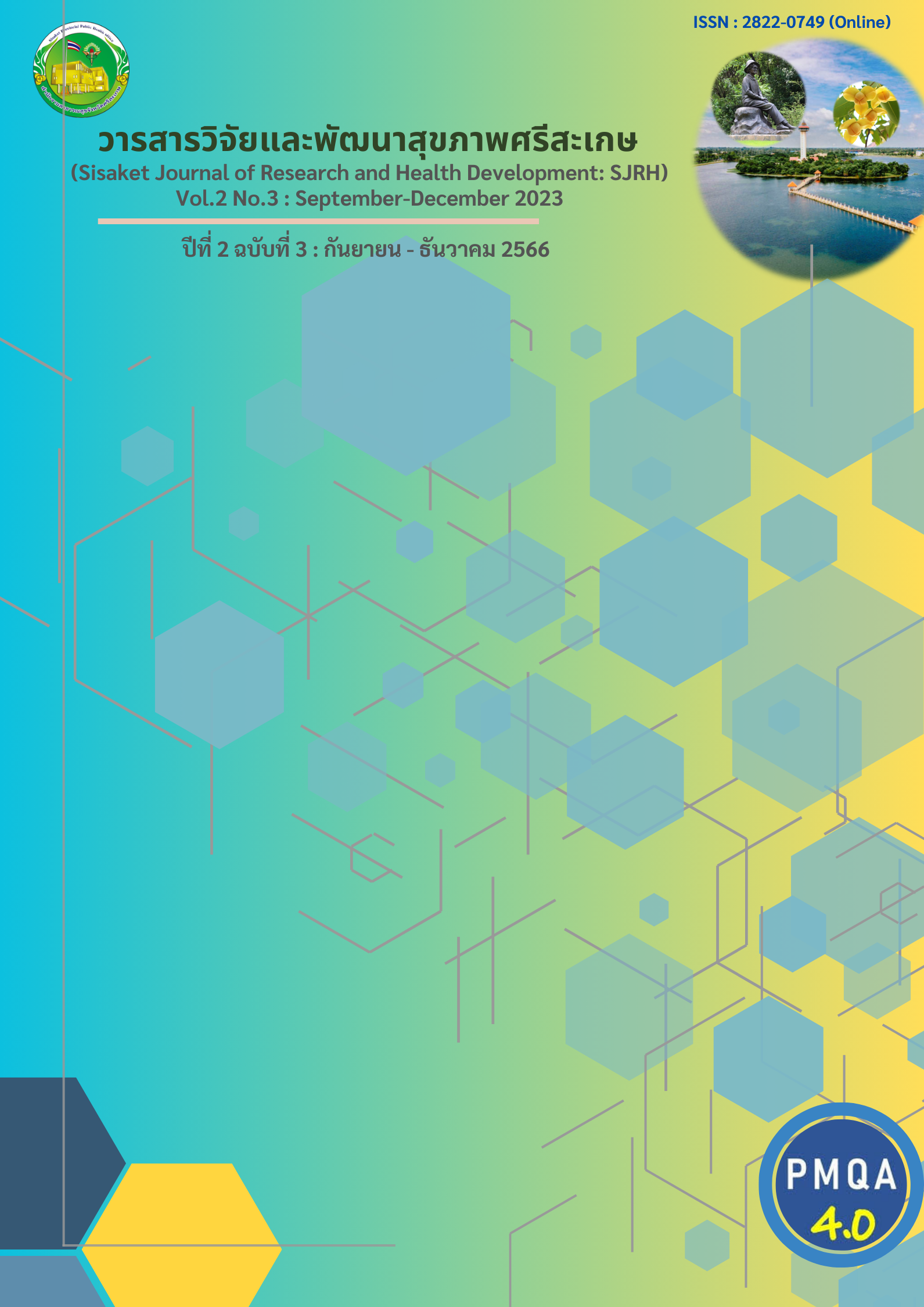Factors Related to success Suicide in Suicidal Attemp Patient in Sisaket Province
Main Article Content
Abstract
Suicide is a serious public health concern worldwide. This study aimed to investigate the risk factors that related to suicide success among suicidal attempt people in Sisaket province. It is a retrospective cohort study. Data from Sisaket’s national disease surveillance (report 506) between 2022 to 2023 was collected. Among them, 100 people had successful suicide, and 282 people had unsuccessful suicide. The chi-square test for univariate analysis was used to analyze risk factors. Then, multivariate logistic regression analysis was performed to find the risk factors for suicidal attempts. among people with suicidal attempts.
This study found that most of the people were female (62.3%), most of them aged less than 50 years (84.6%), and the mean age was 29.88 years. Most of them were single (62.6%) or divorced (10.7%). And 33.2% of them were diagnosed with depressive disorder. There were 58 people, of which 15.2% had an underlying disease. Also, there were 141 people (36.9%) who had a history of suicidal attempts. Multiple logistic regression analysis was analyzed the risk factors of male gender (Adj. OR =12.12, 95%CI 5.32-27.61, p<0.001) and age more than 50 years (Adj. OR =3.93, 95%CI 1.65-9.36, p=0.002). In addition, other risk factors, including early signal will be harmful themselves (Adj. OR =3.31, 95%CI 162-6.76, p=0.001), alcohol use (Adj. OR =2.48, 95%CI 1.19-5.20, p=0.016) and financial problems (Adj. OR =4.85, 95%CI 1.90-12.41, p=0.001). In conclusion, the risk factors for suicidal attempts in Sisaket province are age, gender, early signals that will harm themselves, alcohol use, and financial problems.
Article Details

This work is licensed under a Creative Commons Attribution-NonCommercial-NoDerivatives 4.0 International License.
เนื้อหาและข้อมูล (เขียนข้อกำหนด)
References
ธัญชนก บุญรัตน์(2559). พฤติกรรมการฆ่าตัวตายของ ผู้ป่วยที่มารักษาที่คลินิกจิตเวช โรงพยาบาลหาดใหญ่. วารสารวิชาการแพทย์ เขต11 ;30(1):101-9. https://he02.tci-thaijo.org/index.php/Reg11MedJ/article/view/177583
จินตนา กมลพันธ์ และวันรวี พิมพ์รัตน์(2563). ปัจจัย ที่มีผลต่อการฆ่าตัวตายชองผู้ป่วยคลินิกให้คำปรึกษา กลุ่มงานจิตเวชและยาเสพติด โรงพยาบาลบุรีรัมย์. วารสารการแพทย์โรงพยาบาลศรีสะเกษ สุรินทร์ บุรีรัมย์ ;35(2):481-90. https://he02.tci-thaijo.org/index.php/MJSSBH/article/view/247470
Chaniang, S., Klongdee, K., & Jompaeng, Y. (2022). Suicide prevention: A qualitative study with Thai secondary school students. Belitung Nurs J, 8(1), 60-66. https://doi.org/10.33546/bnj.1746.
Choi, S. B., Lee, W., Yoon, J. H., Won, J. U., & Kim, D. W. (2017). Risk factors of suicide attempt among people with suicidal ideation in South Korea: a cross-sectional study. BMC Public Health, 17(1), 579. https://bmcpublic
health.biomedcentral.com/articles/10.1186/s12889-017-4491-5.
Hegerl, U. (2016). Prevention of suicidal behavior. Dialogues Clin Neurosci, 18(2), 183-190. https://doi.org/10.31887/DCNS.2016.18.2/uhegerl
Johnsson Fridell, E., Ojehagen, A., & Träskman-Bendz, L. (1996). A 5-year follow-up study of suicide attempts. Acta Psychiatr Scand, 93(3), 151-157. https://doi.org/10.1111/j.1600-0447.1996.tb10622.x
Probert-Lindström, S., Berge, J., Westrin, Å., Öjehagen, A., & Pavulans, K. S. (2020). Long-term risk factors for suicide in suicide attempters examined at a medical emergency in patient unit: results from a 32-year follow-up study. BMJ Open, 10(10), e038794. https://doi.org/10.1136/bmjopen-2020-038794

